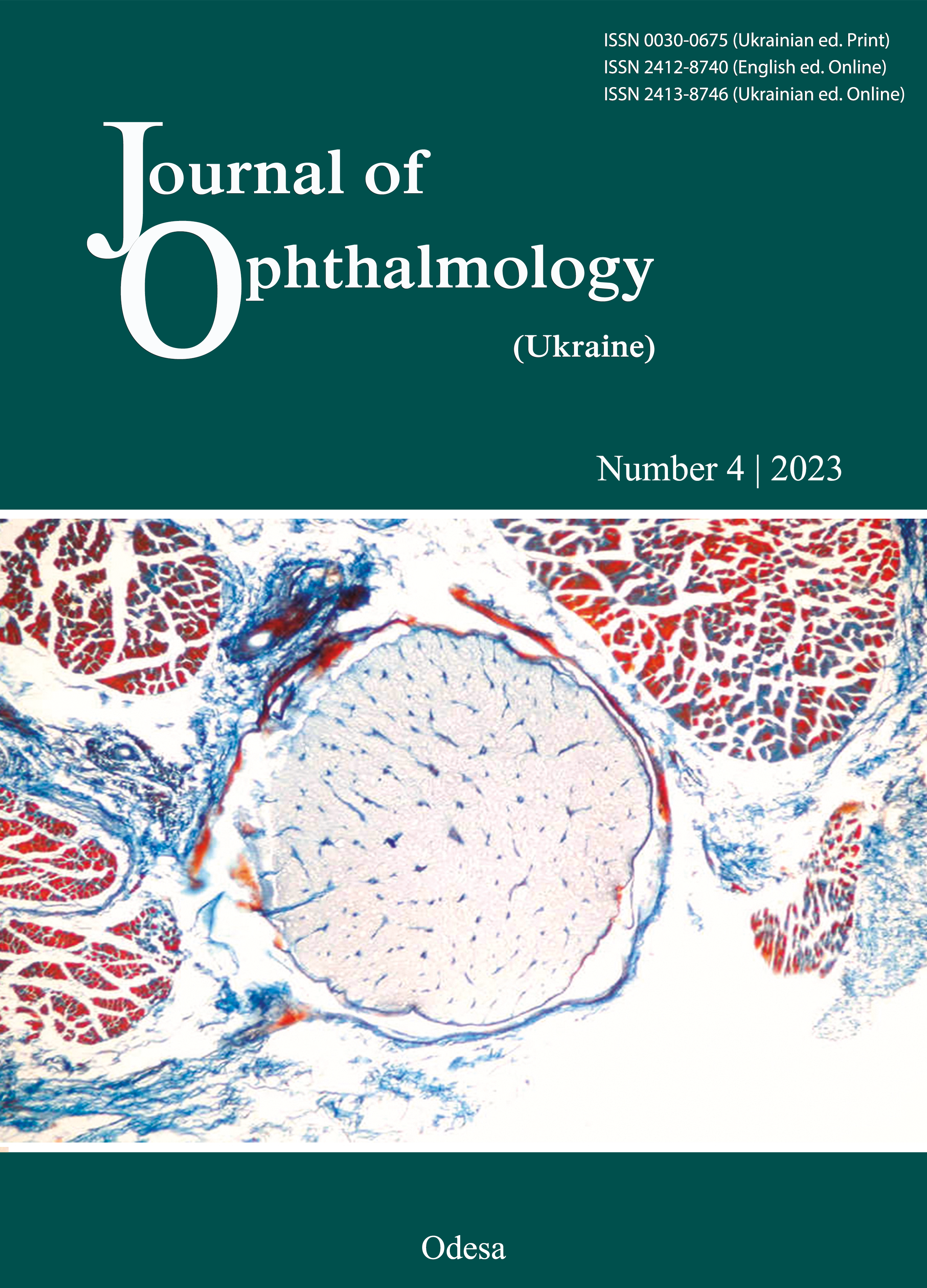Nasal septal deviation and olfactory dysfunction: septoplasty and autoplatelet mesoconcentrate
DOI:
https://doi.org/10.31288/oftalmolzh202344147Keywords:
nasal septal deviation, septoplasty, COVID-19, olfactory dysfunction, nasolacrimal duct obstruction, autoplatelet mesoconcentrateAbstract
Background: Nasal septal deviation (NSD) prevalence rates in the general population range between 75% and 89.2%. The disease results in disorders of the ear, throat and nose, olfactory dysfunction (OD) in the form of hyposmia or anosmia, nasolacrimal duct obstruction, and, consequently, chronic dacryocystitis and low quality of life. Surgery for NSD (septoplasty) can be followed by postoperative anosmia. The three-year COVID-19 pandemic worsened the histories of candidates for septoplasty and the prognosis for surgical outcome in terms of restoration of smell. The methods available for the treatment of OD require close cooperation of specialties like ophthalmology, otorhinolaryngology and neuropathology. Cell-therapy technologies and application of platelet-reach plasma (PRP) seem to be promising in the treatment of NSD and OD.
Purpose: To improve the efficacy of septoplasty for patients with NSD-associated OD through the use of autoplatelet mesoconcentrate (APMC).
Material and Methods: One hundred and fifty-five individuals underwent examination and treatment. These included 22 apparently healthy volunteers aged 25 to 34 years (group 1 or control group), 47 patients with NSD-associated OD only aged 24 to 33 years (group 2 or archival group), 44 patients with NSD-associated OD only aged 23 to 35 years (group 3), and 42 patients with NSD-associated OD and a history of COVID-19 aged 23 to 36 years (group 4). Ten of the patients of group 4 had nasolacrimal duct obstruction.
Results: Our magnetic resonance imaging (MRI) studies found that olfactory bulb volume was 27.2% and 54.5% decreased in groups 3 and 4, respectively, compared to healthy volunteers. A procedure for obtaining at least 24 ml of APMC was described. A 4–mm diameter endoscope (Karl Storz, Germany) was used to perform septoplasty under general endotracheal anesthesia in groups 2, 3 and 4. Application of APMC after endoscopic septoplasty in patients presenting with NSD-associated OD, a history of COVID-19 contributed to the normalization of olfactory bulb volume, reduction in postoperative complication rate, and restoration of the sense of smell and quality of life. Application of APMC after endoscopic septoplasty in patients presenting with NSD-associated OD, a history of COVID-19 and nasolacrimal duct obstruction, contributed to restoration of nasolacrimal duct patency, thus preventing chronic dacryocystitis.
References
Alghamdi FS, Albogami D, Alsurayhi AS, Alshibely AY, Alkaabi TH, Alqurashi LM, et al. Nasal Septal Deviation: A Comprehensive Narrative Review. Cureus. 2022 Nov 10;14(11):e31317. doi: 10.7759/cureus.31317. https://doi.org/10.7759/cureus.31317
Mladina R, Cujić E, Subarić M, Vuković K. Nasal septal deformities in ear, nose, and throat patients: an international study. Am J Otolaryngol. 2008 Mar-Apr;29(2):75-82. https://doi.org/10.1016/j.amjoto.2007.02.002
Thangaleela S, Sivamaruthi BS, Kesika P, Bharathi M, Chaiyasut C. Nasal Microbiota, Olfactory Health, Neurological Disorders and Aging-A Review. Microorganisms. 2022 Jul 12;10(7):1405. https://doi.org/10.3390/microorganisms10071405
LechienJR, JourneF, HansS, Chiesa-EstombaCM, MustinV, BeckersE, et al. Severity of Anosmia as an Early Symptom of COVID-19 Infection May Predict Lasting Loss of Smell. Front Med (Lausanne). 2020 Nov 24;7:582802. https://doi.org/10.3389/fmed.2020.582802
Lechien JR, Vaira LA, Saussez S. Prevalence and 24-month recovery of olfactory dysfunction in COVID-19 patients: A multicentre prospective study. J Intern Med. 2022 Aug 24:10.1111/joim.13564. https://doi.org/10.1111/joim.13564
Müller CA, Renner B. Riechstörungenevidenzbasiertdiagnostizieren und behandeln. Der unterschätzte Sinn - neueErkenntnissebelegen die Bedeutung und Leistungsfähigkeit des menschlichenGeruchssinns [Diagnosis and Therapy of Olfactory Dysfunction - State of the Art The neglected sense-new evidence highlights the significance of the human sense of smell]. Wien Med Wochenschr. 2022 Feb;172(1-2):8-13. German. https://doi.org/10.1007/s10354-021-00895-x
Ramer J, Hellings P, Lund VJ, Alobid I, Beale T, Dassi C, et al. European position paper on diagnostic tools in rhinology. Rhinology. 2019 Jul 25;57(Suppl S28):1-41. https://doi.org/10.4193/Rhin19.410
Tsepkolenko AV. Olfactory dysfunction and olfactory bulb volume в patients with deviated nasal septum. Radiation diagnostics, radiation therapy. 2021; 12(4):7-11. https://doi.org/10.37336/2707-0700-2021-4-1
Stewart MG, Witsell DL, Smith TL, et al. Development and validation of the Nasal Obstruction Symptom Evaluation (NOSE) scale. Otolaryngol Head Neck Surg. 2004 Feb;130(2):157-63. doi: 10.1016/j.otohns.2003.09.016. https://doi.org/10.1016/j.otohns.2003.09.016
Antomonov MYu. [Mathematical processing and analysis of medical and biological data]. Kyiv: Medinform;2018. Russian.
Tan CJ, Tan BKJ, Tan XY, Liu HT, Teo CB, See A, et al. Neuroradiological Basis of COVID-19 Olfactory Dysfunction: A Systematic Review and Meta-Analysis. Laryngoscope. 2022 Jun;132(6):1260-1274. https://doi.org/10.1002/lary.30078
Ku JY, Lee MK, Choi WR, Lee JH, Kim JH. Effect of olfactory bulb atrophy on the success of olfactory training. Eur Arch Otorhinolaryngol. 2021 Jun 6. https://doi.org/10.1007/s00405-021-06917-z
Troha K, Vozel D, Arko M, Bedina Zavec A, Dolinar D, Hočevar M, et al. Autologous Platelet and Extracellular Vesicle-Rich Plasma as Therapeutic Fluid: A Review. Int J Mol Sci. 2023; 24(4):3420.
https://doi.org/10.3390/ijms24043420
Everts P, Onishi K, Jayaram P, Lana JF, Mautner K. Platelet-Rich Plasma: New Performance Understandings and Therapeutic Considerations in 2020. Int J Mol Sci. 2020; 21(20):7794. https://doi.org/10.3390/ijms21207794
Downloads
Published
How to Cite
Issue
Section
License
Copyright (c) 2023 Tsepkolenko O. V., Pukhlik S. M.

This work is licensed under a Creative Commons Attribution 4.0 International License.
This work is licensed under a Creative Commons Attribution 4.0 International (CC BY 4.0) that allows users to read, download, copy, distribute, print, search, or link to the full texts of the articles, or use them for any other lawful purpose, without asking prior permission from the publisher or the author as long as they cite the source.
COPYRIGHT NOTICE
Authors who publish in this journal agree to the following terms:
- Authors hold copyright immediately after publication of their works and retain publishing rights without any restrictions.
- The copyright commencement date complies the publication date of the issue, where the article is included in.
DEPOSIT POLICY
- Authors are permitted and encouraged to post their work online (e.g., in institutional repositories or on their website) during the editorial process, as it can lead to productive exchanges, as well as earlier and greater citation of published work.
- Authors are able to enter into separate, additional contractual arrangements for the non-exclusive distribution of the journal's published version of the work with an acknowledgement of its initial publication in this journal.
- Post-print (post-refereeing manuscript version) and publisher's PDF-version self-archiving is allowed.
- Archiving the pre-print (pre-refereeing manuscript version) not allowed.












